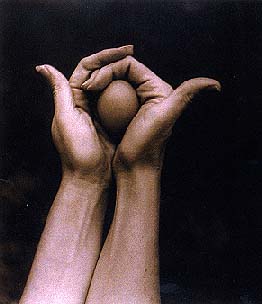| Assemblage Points and Instant Change | 2004-05-30 09:29 7 comments |
 by Flemming Funch by Flemming FunchIn Carlos Castaneda's books, his teacher, the mysterious sorcerer Don Juan Matus, taught him about what he called the "assemblage point". It is thought to be the point where one's perception is assembled, which determines the particular world one is seeing and living in. In normal humans it is considered to be an armslength behind one's back, between the shoulder blades. And that is the point that allows us to live in the normal human world, with our normal limited human perceptions, and our normal attachment to human self-importance. And that we're pretty stuck with that point. But if one manages to shift that assemblage point to a different location, one moves into a different world. A slightly different world, or a very different and bizarre world. Either way, it is in no way easy, but can be accomplished with the right kind of practice. When we dream at night, the assemblage point is naturally more loose and moves about. The hard part is to do it consciously and deliberately. A person who has an unstable assemblage point in waking life is what we'd call a schizophrenic. Typically one has a very hard time remembering anything that happens in other points than one's normal position. So, if somebody manages to switch you between several points, you might not remember what happened in the other position. You might be somebody who works at night on a secret black government project, while being somebody else during the day, and yourself having no clue about it. It relates to the more palatable concept of world views. If you have a certain world view, based on certain beliefs and assumptions, you tend to mentally wear a certain set of colored glasses, that makes you see only what fits into that world view. What fits within it seems normal and reasonable, and what doesn't seems crazy and non-sensical or non-existent. But the assembly point idea is really much more radical than that. Not just a set of pre-conceived ideas, but more like the ability to switch between different realities. In a multi-dimensional many-worlds universe, the dial gets turned to a different position, and you perceive a totally different band filtered out from the quantum soup. If you can turn it, that is, which most people can't. Not that I can see such things as assembly points, and I have no clue if the position given is correct, of if it is altogether more useful as a metaphor. But that kind of thing does fit with my own view of how the multiverse works. And it provides some clues for how to solve big problems. In my own experience, transformative changes happen in the form of shifts, rather than as gradual and incremental change. Personal change happens that way. The actual change is instantaneous. Suddenly things are different. All sorts of things might have led up to it, and there might be all sorts of reasonable explanation for how somebody might have come to change, by working through their issues, or whatever, but the actual change is typically instant. And few people actually notice it themselves, exactly because one kind of becomes a different person, and it is very difficult remembering being anyone different. So, instant shifts give rise to a considerable amount of denial. Likewise with societal change. Sure, all sorts of trends of change are happening. More of this, less of that. Plans, influences, discussions, memes. But the real changes are usually from a moment to the next. We suddenly notice that things seem different in our culture. And then we rationalize it away, analyze it, coming up with good reasons for believing that it was a gradual thing that logically happened. It usually wasn't. The most important changes are discontinuous and disruptive. Sure, it might be based on an identifiable event. We see man walk on the moon - the world is different. The IBM PC goes on sale - the world changes. 9-11 - bing - the world is never the same again. But not all big changes have obvious trigger events. And I claim that the real change is the instant shift in consciousness, individually or as a group. The whole world changes in a moment, without going through any steps in-between. It goes from a world with certain rules to a different world with different rules. And most people don't notice, again, because they're not capable of being conscious of shifts, and because it is so easy to explain it away. There are still trees and cars and buildings and cottage cheese in the world, so it must be the same world. Potentially there's an important point here, which might give cause for optimism on many fronts. On our planet we've collectively gotten ourselves into a great deal of messes that we have no obvious or easy way out of. And if we extrapolate various trends into the future, it is not in any way obvious that we'll solve them, or that we'll survive for very long. But that is because what will make things work is almost all shifts and disruptive changes, which we mostly can't predict. Or, maybe we can to some degree. Or we can learn how instant world shifts work, rather than trying to master incremental change. But it is a different way of thinking. We might consider how to step into the world that works, where humanity will survive in harmony with ourselves and the world, without necessarily passing through the space in-between. Non-local change. |